| There is a colloquium at the U of R today which you might want to attend: |
 Copyright © Michael Richmond.
This work is licensed under a Creative Commons License.
Copyright © Michael Richmond.
This work is licensed under a Creative Commons License.
| There is a colloquium at the U of R today which you might want to attend: |
Kepler's attitude is held steady by four (4) reaction wheels. The craft needs 3 wheels to hold its attitude properly. Unfortunately, some of those wheels have failed:
May 13, 2009: Kepler begins its original mission July 14, 2012: Reaction wheel #1 fails May 11, 2013: Reaction wheel #2 fails -- original mission ends
So, the original mission of Kepler lasted about 4 years.
In November, 2013, NASA announced the "Second Light" mission, also known as "K2". This is a completely new way of using the spacecraft: instead of staring at one region of the sky for years at a time, Kepler will shift its attention to different regions every 83 days.
The basic idea is to use the pressure of sunlight as a replacement for one of the reaction wheels.
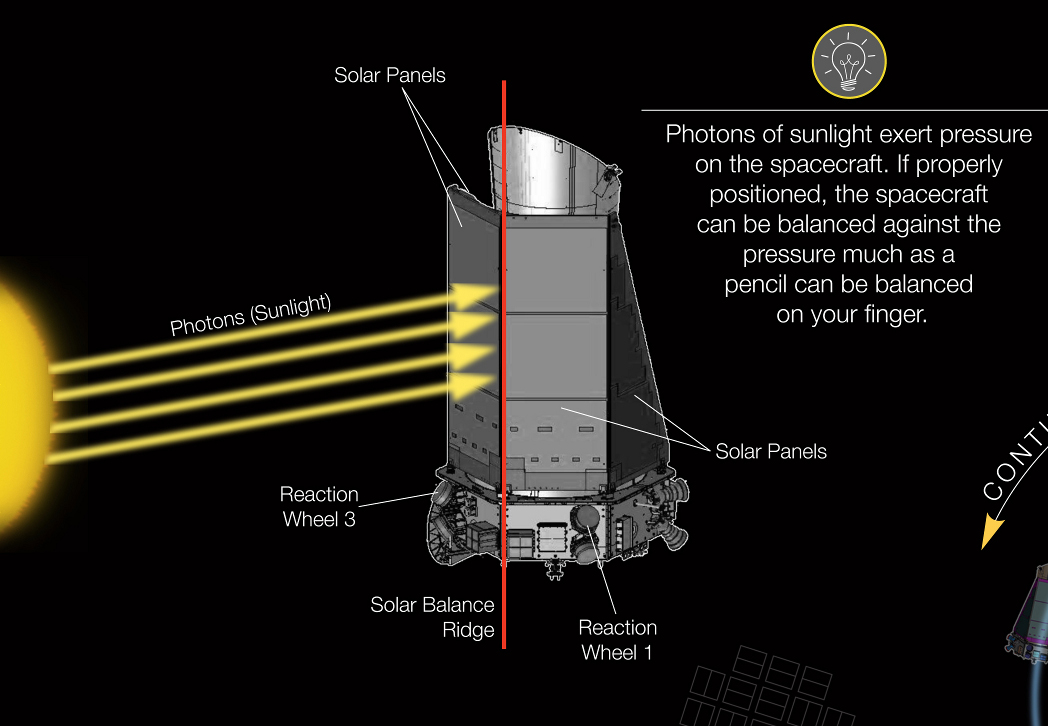
Image courtesy of
NASA Ames/W Stenzel
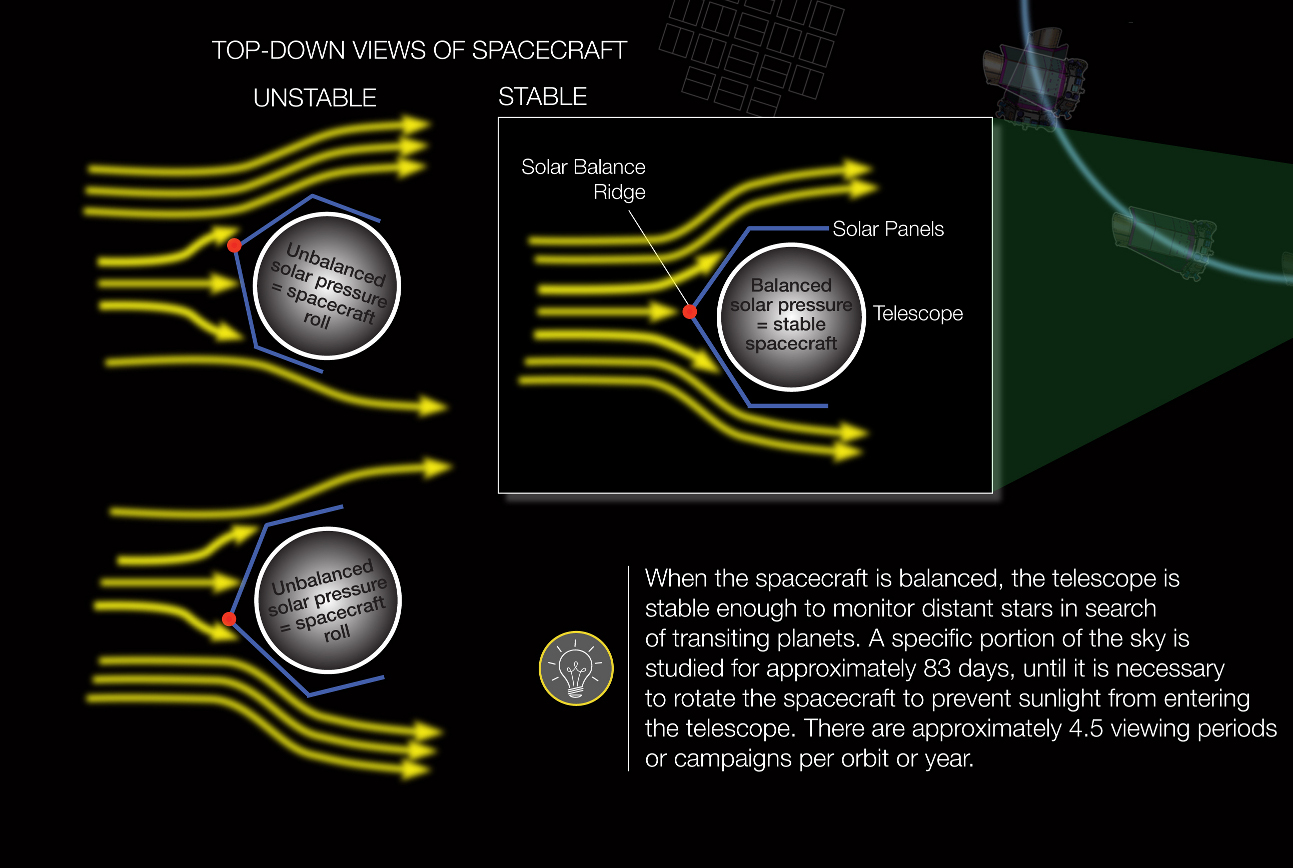
Image courtesy of
NASA Ames/W Stenzel
However, as the spacecraft orbits the Sun, the sunlight will strike it from a different direction. In order to keep the solar panels and sunshade oriented properly, Kepler will have to "roll" itself roughly four times each orbit.
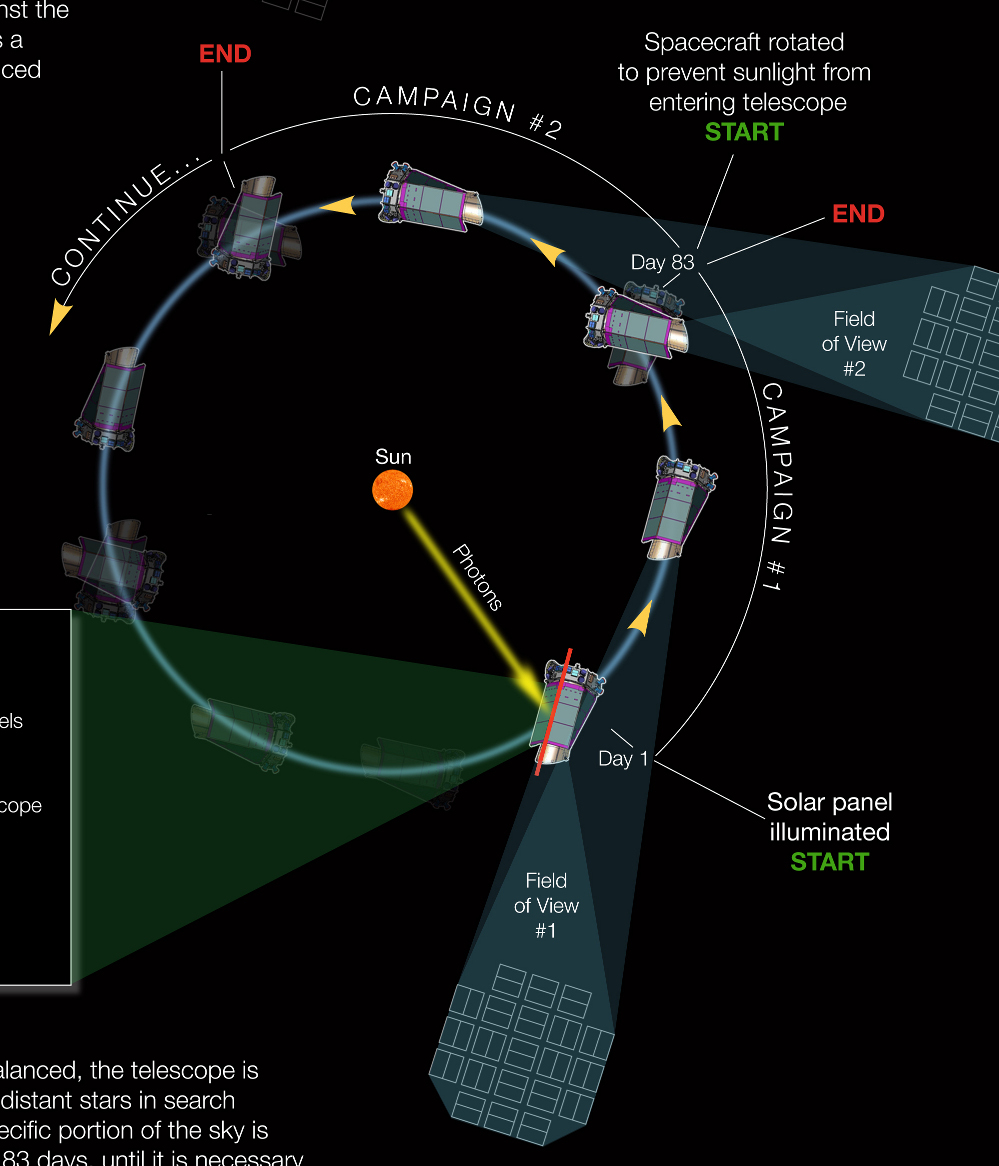
Image courtesy of
NASA Ames/W Stenzel
This means that Kepler's extended mission is broken into 83-day chunks:
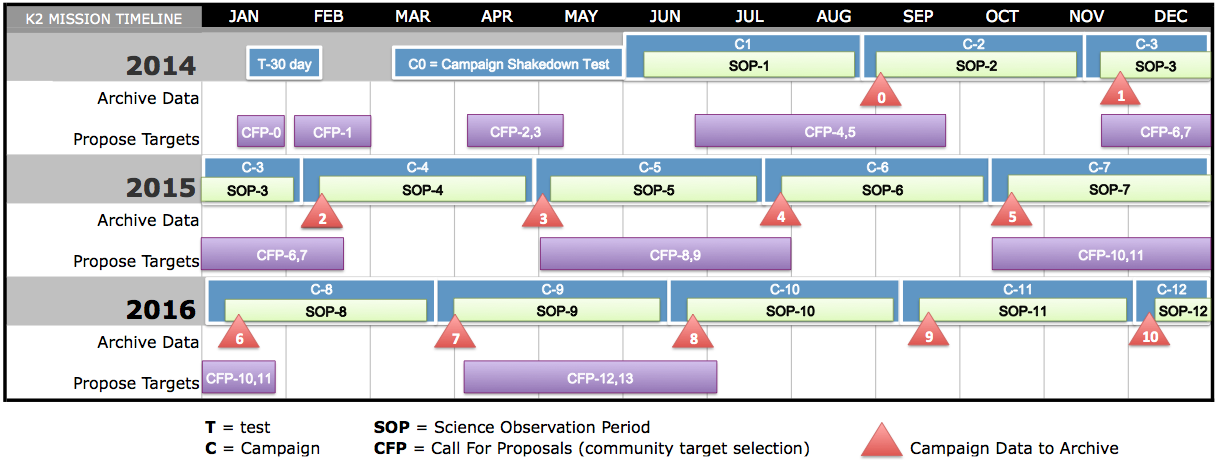
Image courtesy of
WikiWand

Image courtesy of
NASA Kepler mission
Note that most of the time, Kepler faces "backwards" in its orbit, away from the Earth. In this orientation, the target field is sort of in the "daytime" half of the sky, and so difficult for ground-based astronomers to see at the same time as Kepler.
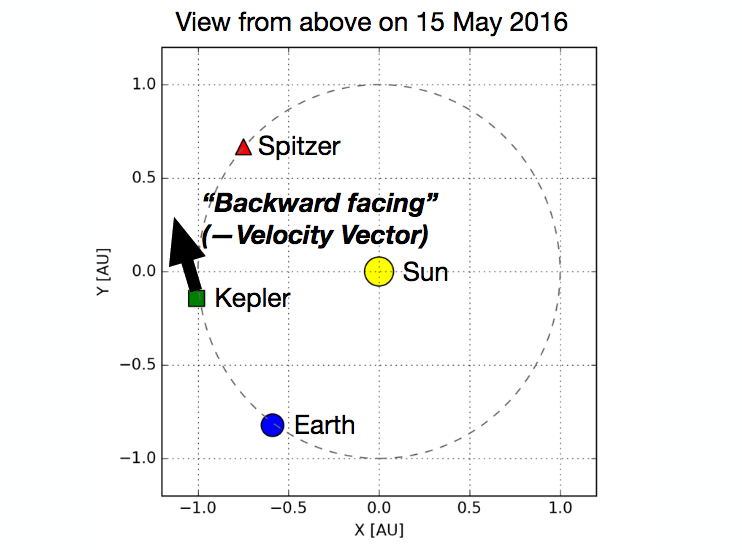
From
a presentation by Geert Barentsen and Tom Barclay.
But field K2-16 will be special in two ways: it will in large part overlap K2-5, and Kepler will observe in forward-facing mode. This means that ground-based astronomers can easily make measurements at the same time as the spacecraft.
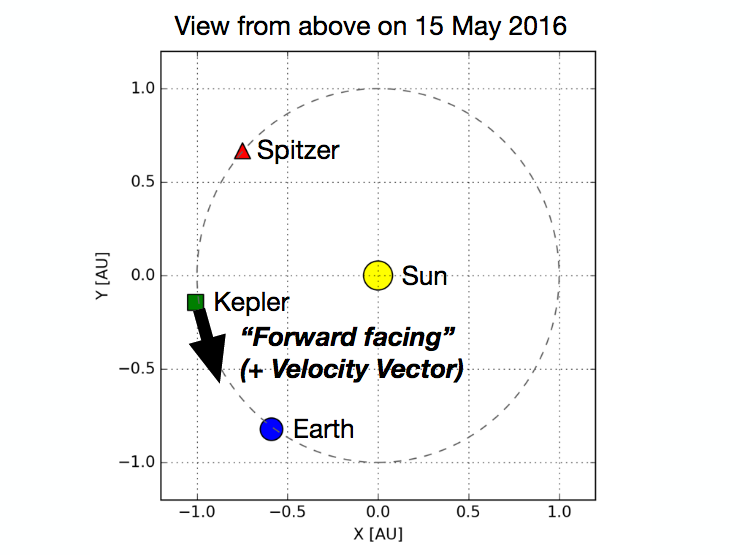
From
a presentation by Geert Barentsen and Tom Barclay.
You can find a list of these fields at
Q: How will these changes to Kepler _operations_ affect
the types of planets it may find?
Does the loss of reaction wheels cause any loss of precision in the data? Alas, yes. Because the spacecraft cannot be held as steady, stars will move across the focal plane -- in patterns both "fast" (over hours) and "slow" (over days). You can read some of the details at the K2 Spacecraft Operation page.
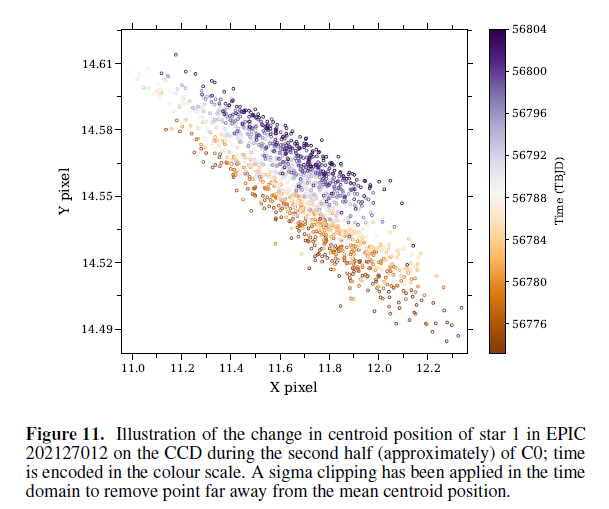
Fig 11 from
K2P2 - A photometry pipeline for the K2 mission
These motions in the focal planet cause big variations in the apparent brightness of stars, of course.
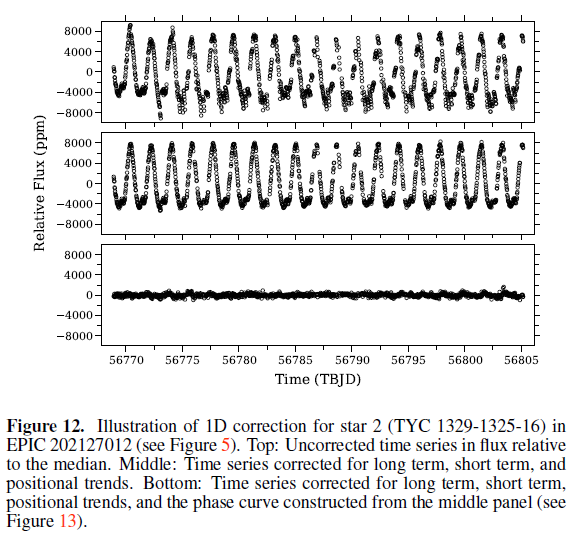
Fig 12 from
K2P2 - A photometry pipeline for the K2 mission
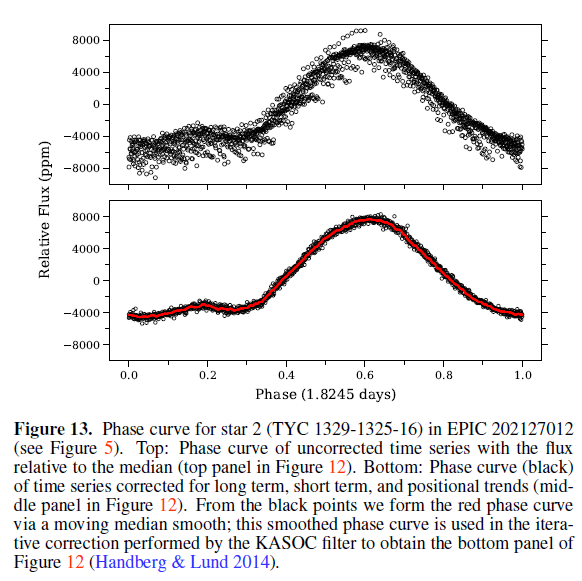
Fig 13 from
K2P2 - A photometry pipeline for the K2 mission
The result of all this drifting is an increase in the noise of each measurement. The bottom line is that the precision of bright stars will degrade from roughly 20 ppm to maybe 90 ppm when averaged over 6-hour periods.
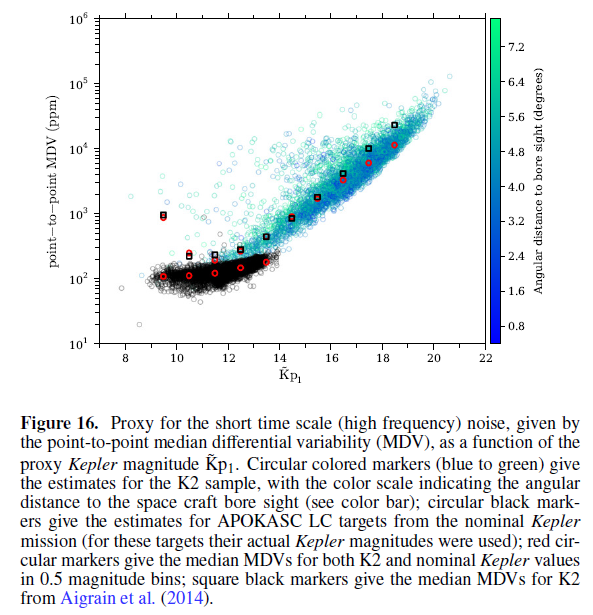
Fig 16 from
K2P2 - A photometry pipeline for the K2 mission
Kepler can still find planets -- but perhaps not quite as well as it could in the past.
A more recent comparison of fully reduced data from the original Kepler mission (in blue) and K2 mission (in orange) shows that the precision of data averaged of 6-hour periods is still very, very good.
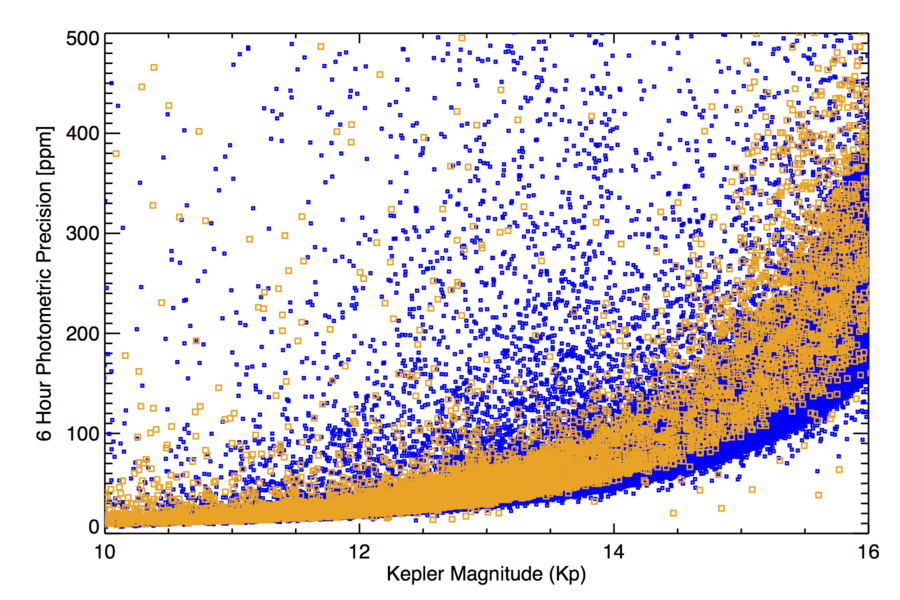
Image taken from
the K2 Observing website.
Some sample K2 light curves from a recent arXiv preprint by Montet et al. provide a hint of what we can expect from K2.
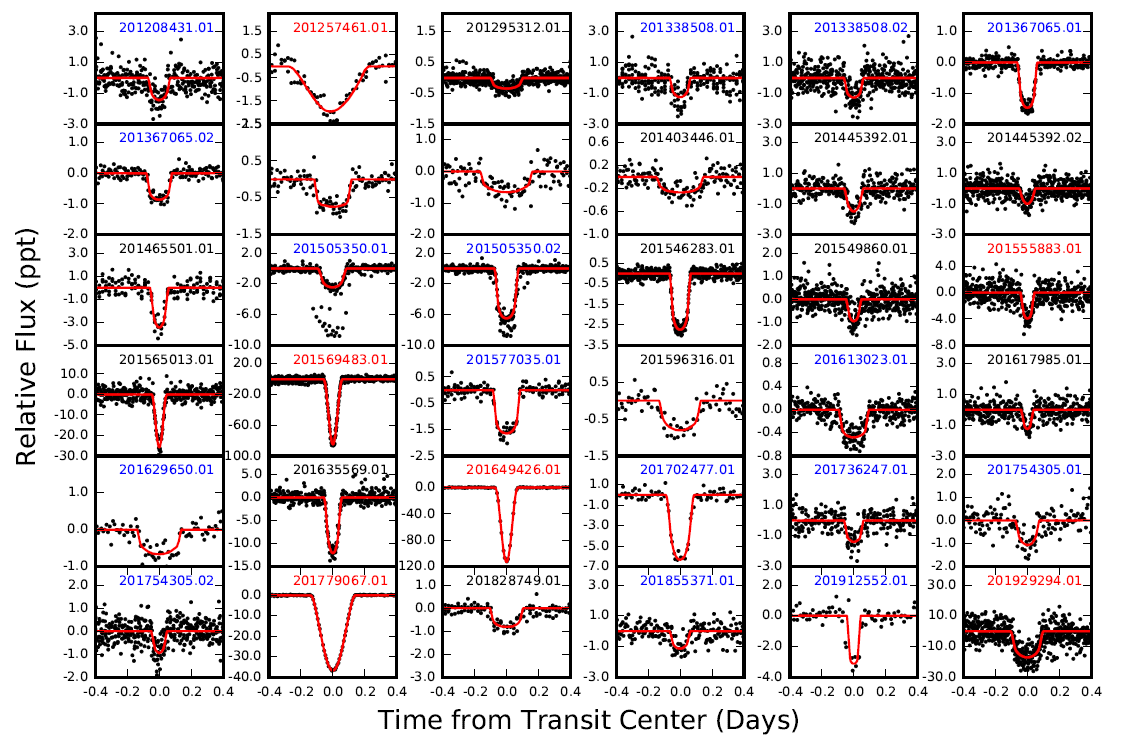
Image taken from
a recent arXiv preprint by Montet et al.
Q: How will these changes to Kepler _precision_ affect
the types of planets it may find?
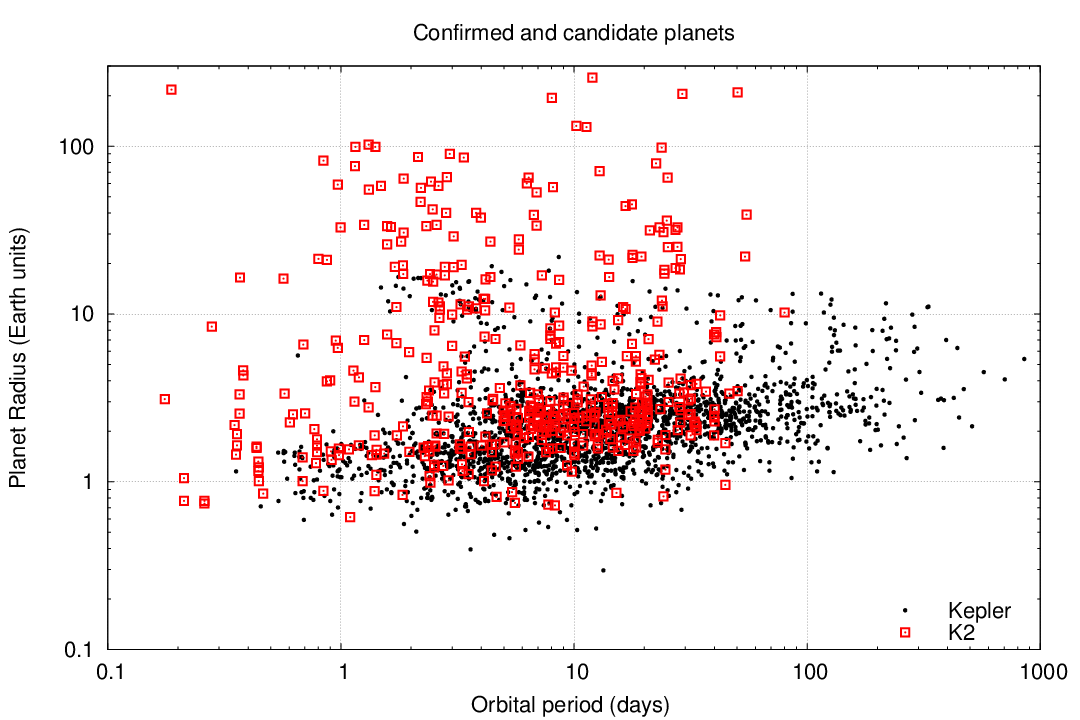
Transiting Exoplanet Survey Satellite
TESS is scheduled to be launched some time after April 16, 2018 -- real soon!
TESS launched YESTERDAY!
It is designed specifically to look for transiting planets .... but in quite a different manner than Kepler did. Some of the main differences are:
Let's look at the mission in some detail.
Like Kepler, TESS collects light over a wide optical range in order to gather as many photons as possible. TESS's overall passband is considerably more red.
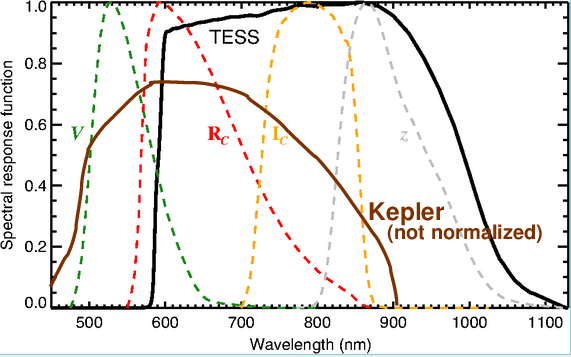
There are four cameras, each with an aperture of 10.5 cm.
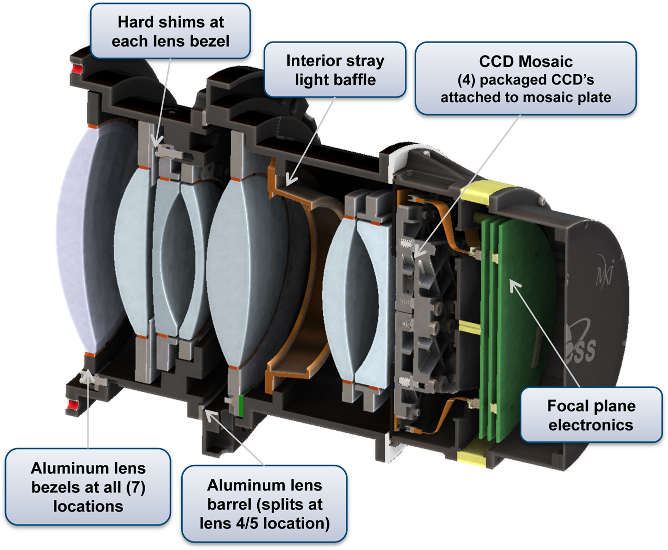
The cameras each focus light onto a mosaic of four 2048x2048 CCDs (each chip has a separate 2048x2048 frame-storage area), with 15-micron pixels. The result is a field of view of 24-by-24 degrees -- wow! The pixels are pretty big, though: about 40 arcseconds on a side.
The cameras acquire images with very short exposure times, just 2 seconds each.
Q: Why are the exposure times so short?
The images are co-added in sets of 60 to form 2-minute "summed images". On-board computers extract pixels from pre-selected subregions of each summed image for further processing. These summed images are co-added in sets of 15 to create "Full-Frame Images" (FFI) with effective exposure times of 30 minutes; these FFI are saved in full and transmitted to Earth.
The four cameras are arranged so that they cover a region of the sky 24-by-96 degrees on a side.
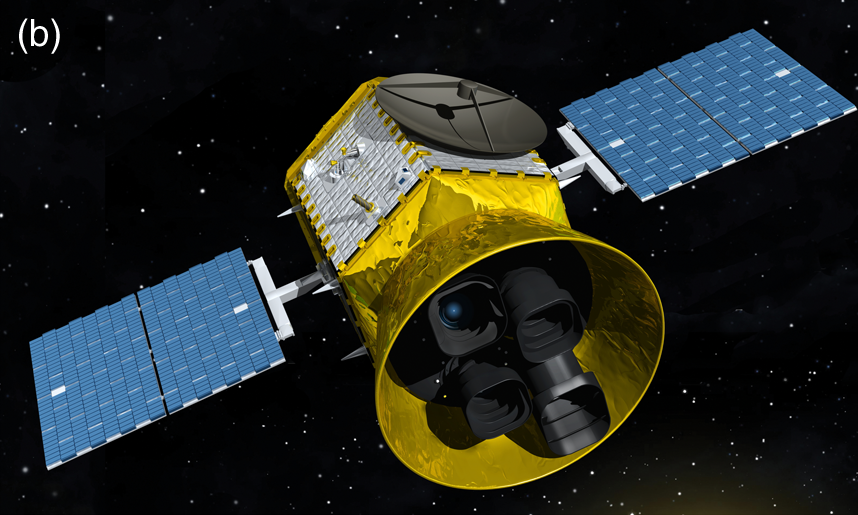
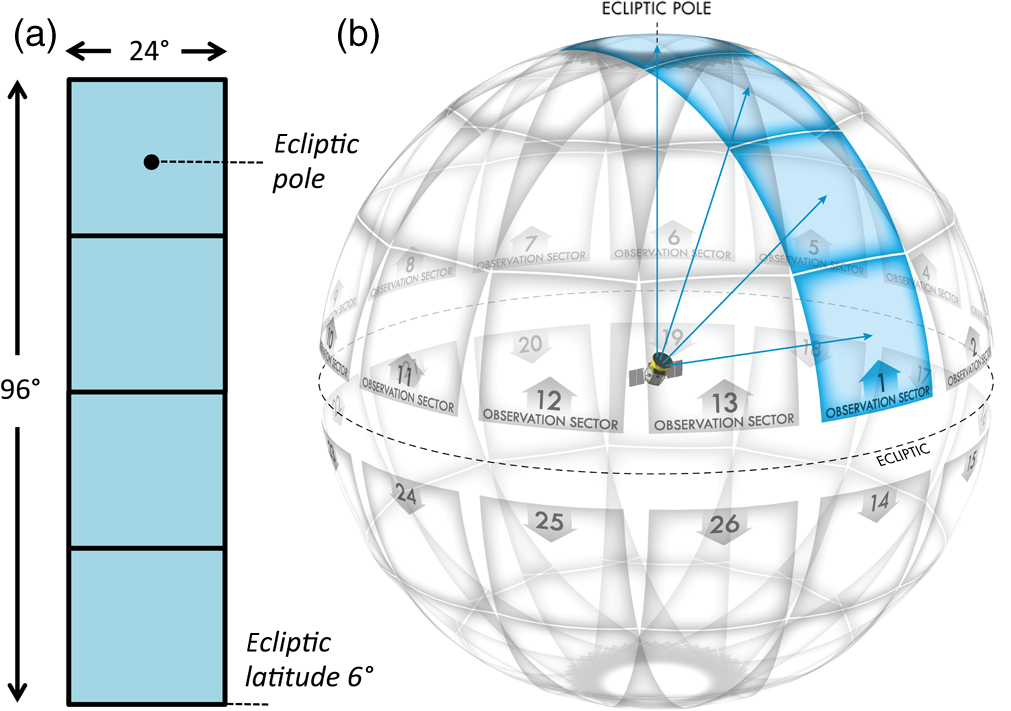
After 26 days, the spacecraft rolls to a new observation sector (which also keeps its solar panels and sunshade oriented properly). Over the course of the first year, TESS will have observed almost the entire northern ecliptic hemisphere, with a region near the ecliptic pole receiving continuous coverage. In Year 2, the spacecraft will repeat the process for the southern ecliptic hemisphere.
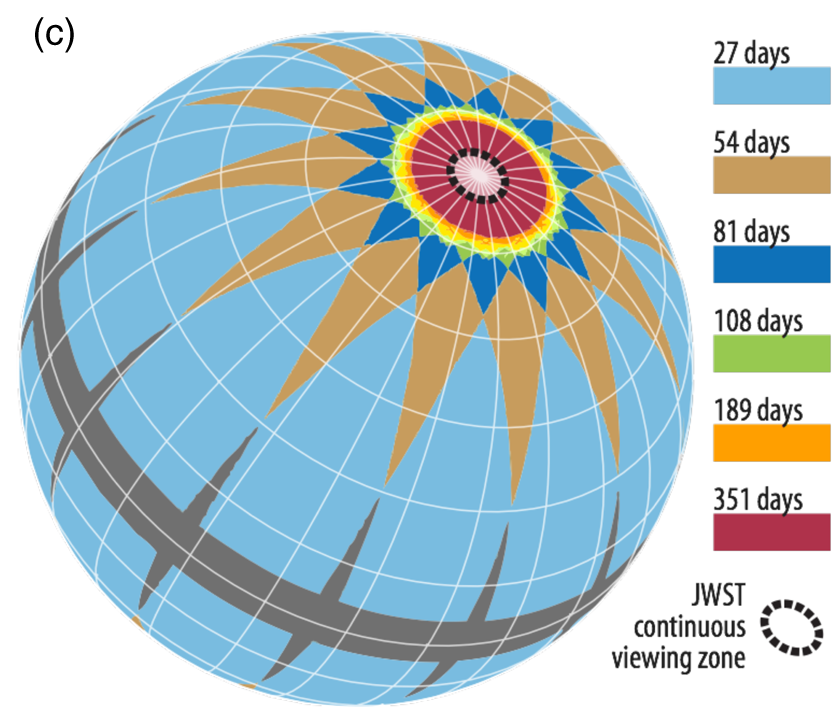
In each hemisphere,
Every 13.7 days, the spacecraft will pass close to the Earth in its orbit. At that time, it will transmit its data collected during the past two weeks. (In the figure below, LAHO = "Low Altitude Housekeeping Operations", and HASO = "High Altitude Science Operations". See the TESS Missions Operations Concept Document for details).
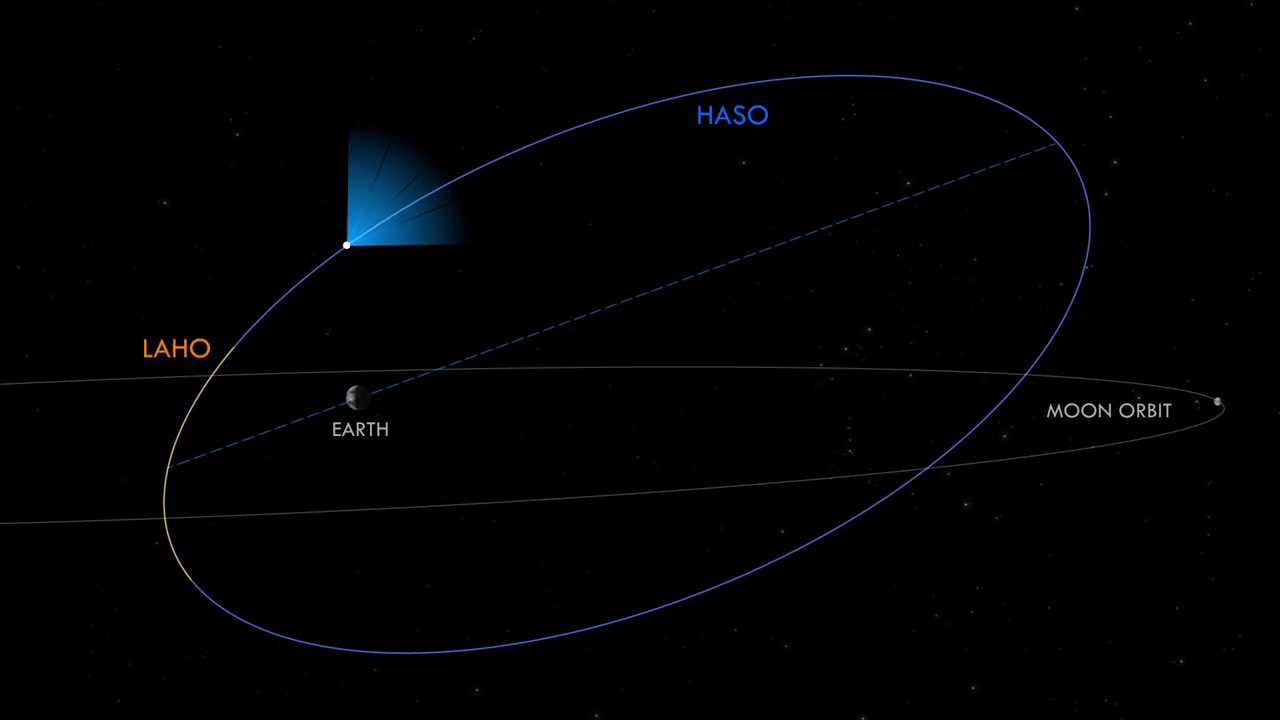
How precise will the measurements of stars be? The predictions suggest a best result which is similar to that of Kepler in its K2 mission: at best 80-100 ppm.
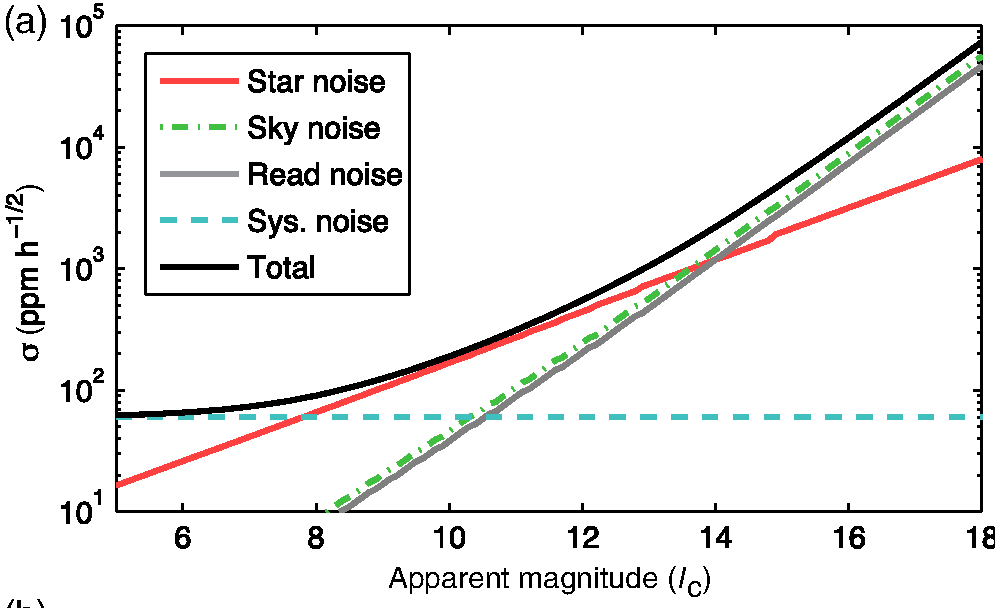
Now, remember: TESS will only measure the brightness of pre-selected stars. How many? The plan is to monitor roughly 200,000 stars over the entire sky; that means roughly 2,000 stars per 24-by-24-degree image, or around 3-4 stars per square degree. These stars will be selected from a pre-launch catalog, focusing on main-sequence FGKM stars.
The TESS team predicts that the mission ought to discover a large number of transiting planets, mostly in the "Super-Earth" size range:
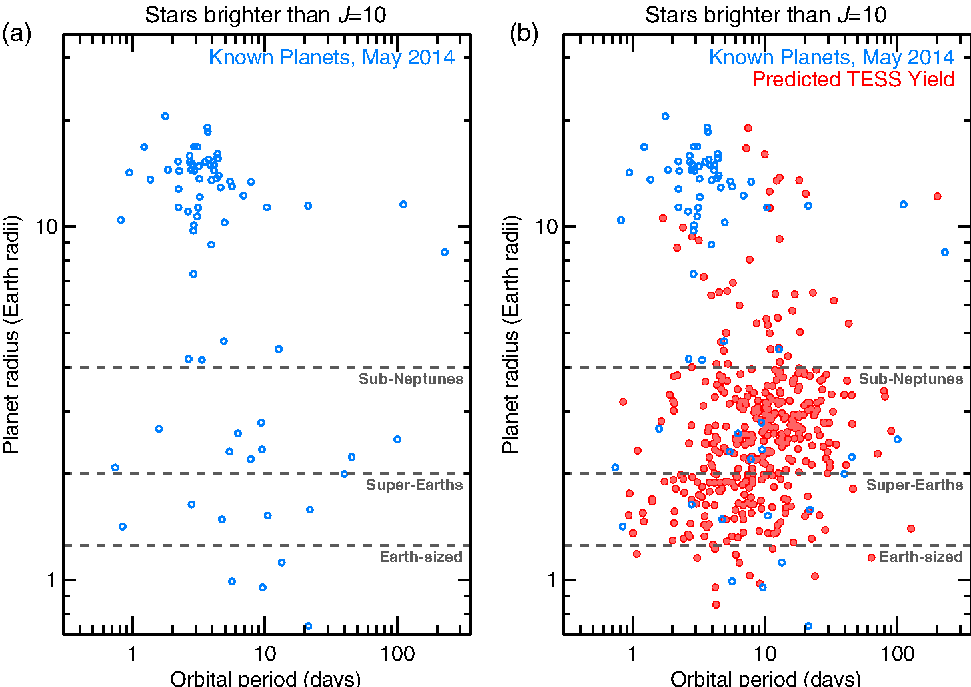
Over the past few years, Kepler has found quite a few planets of this sort. Those found by TESS, however, will on average orbit stars which are much closer to the Sun.
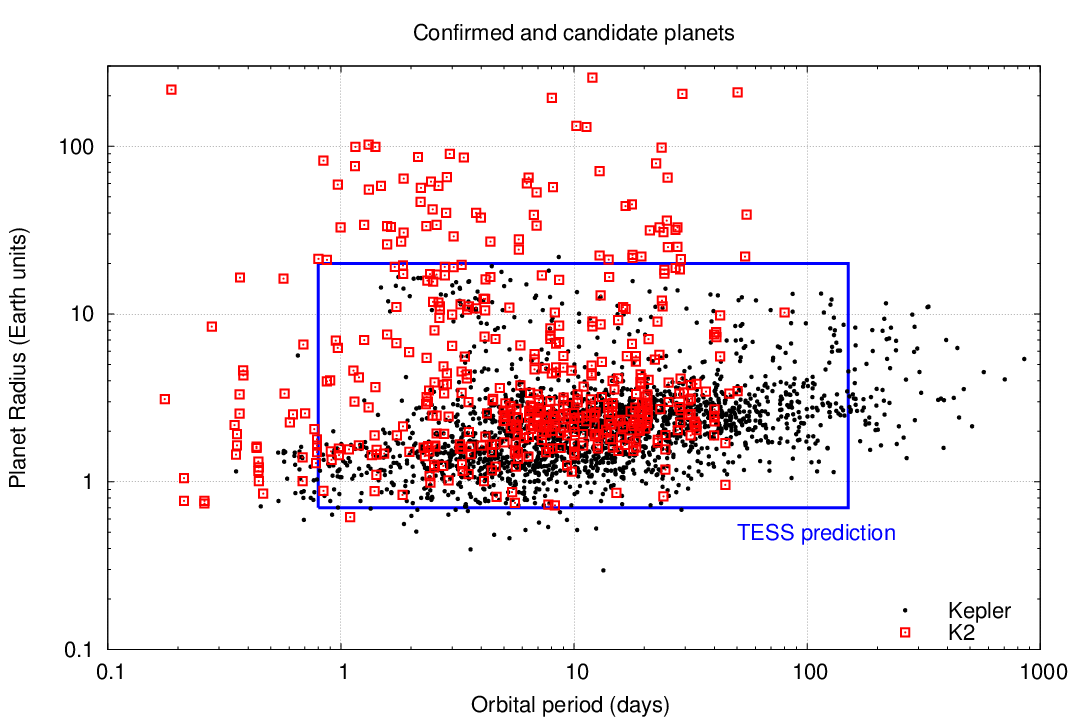
The information TESS gathers can be used for many purposes other than planet searches, of course. Among them are
TESS can be expected to detect p-mode oscillations on about 6000 stars brighter than V=7.5, including
(a) the majority of all stars brighter than V=4.5,
(b) about 75 stars smaller than the Sun,
(c) about 2000 upper-main-sequence and subgiant stars, and
(d) virtually all the giant stars.
Each 30 min FFI will provide precise (approx 5 mmag) photometry for approximately 106 bright galaxies and stars (Ic < 14-15) within a 2300-sq.deg. field.
I will be very happy to look at the variations of AGN and a host of variable stars in each field. If we're lucky, some nearby SNe will explode in them, too.
The Evryscope Project will use a "simple" approach to search an entire visible sky continuously, monitoring bright stars to find exoplanets and other transient sources. What I mean by "simple" is
One of the not-so-simple aspects is the sheer number of cameras in the device: there are 27 (or 23, or 24) little telescopes!
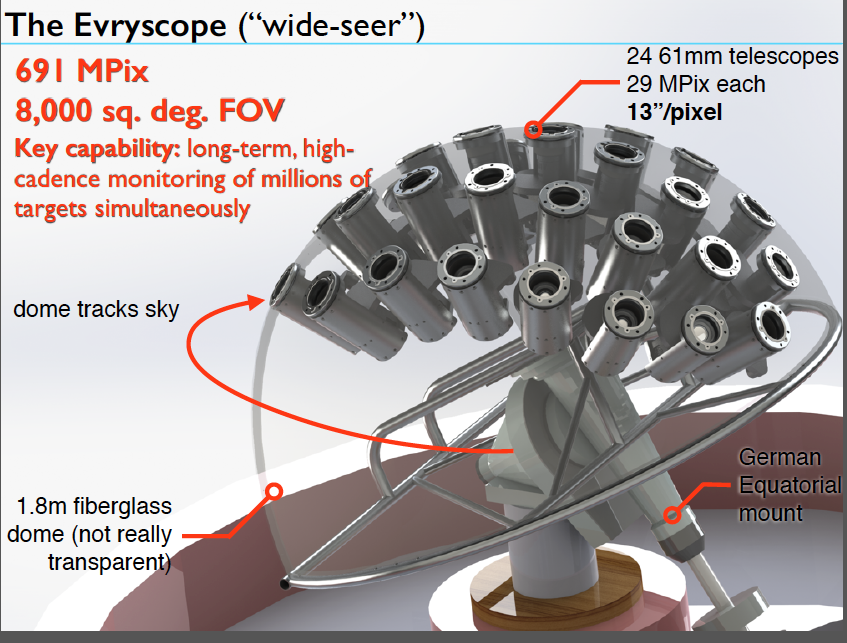
Image taken from
Keith Law's presentation given at 2016 SPIE meeting in Edinburgh
The idea is to arrange the telescopes so that the big field of view of each instrument -- about 24 x 16 degrees -- overlaps its neighbors enough to create an (almost) continuous image of the visible sky. As described in Law et al., PASP 127, 234 (2015), the overall field of view is huge: 8,600 square degrees, or about one fifth of the entire sky.
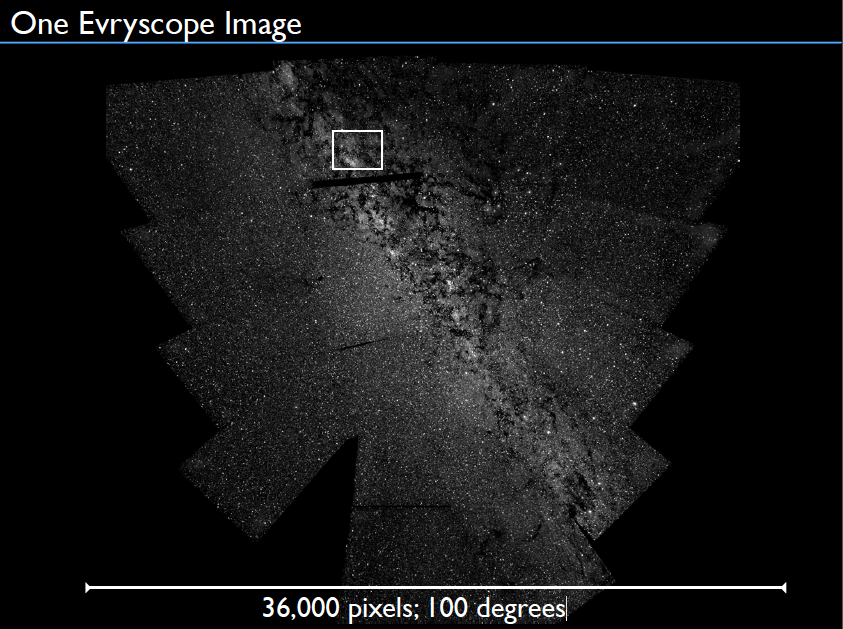
Image taken from
Keith Law's presentation given at 2016 SPIE meeting in Edinburgh
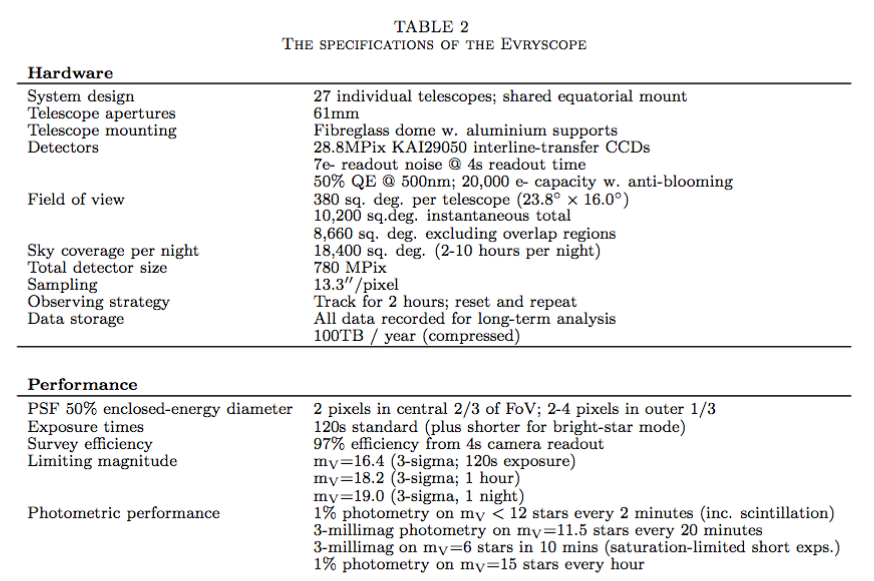
Table 2 taken from
Law et al., PASP 127, 234 (2015),
The cameras will take short, two-minute exposures, which will reach roughly 16th magnitude. Each region of the sky will be followed for about 6 hours per night. By combining many consecutive images of an area, stars down to magnitude 18 or 19 may be measured with low precision.
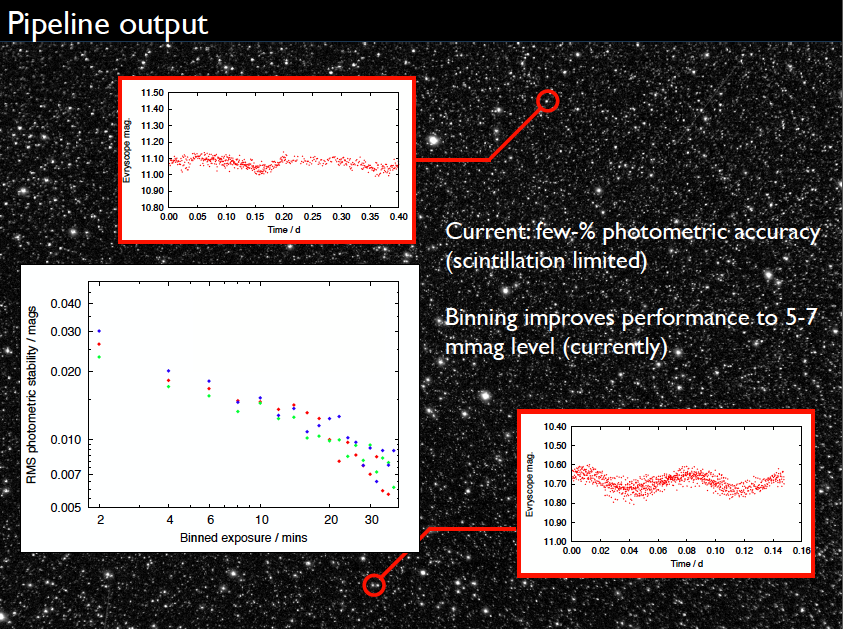
Image taken from
Keith Law's presentation given at 2016 SPIE meeting in Edinburgh
The Evryscope team has tested its ideas by placing individual telescope units in the Canadian Arctic
and at Cerro Tololo International Observatory.
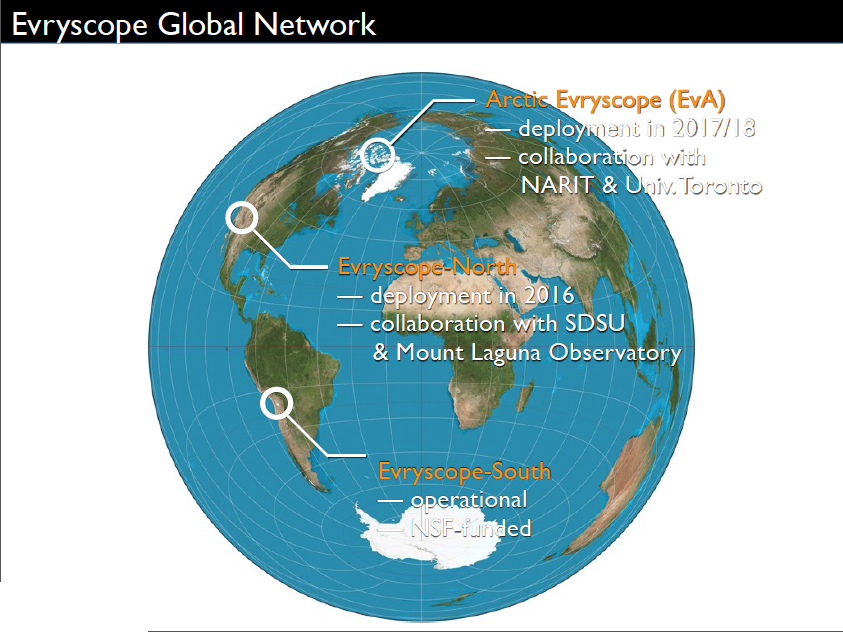
Image taken from
Keith Law's presentation given at 2016 SPIE meeting in Edinburgh
The European Space Agency's CHEOPS mission is sort of the diametric opposite of Evryscope. Instead of using many cheap little telescopes on the ground to observe tens of thousands of stars all over the sky, hoping to find new objects, CHEOPS will use
CHEOPS will focus on a particular group of planets: Super-Earths and Neptunes. The main goals of the project are
As you can see, our current measurements of planet masses and radii have ... rather large uncertainties, which means that we really don't know much about the internal structure of these bodies. CHEOPS will try to shrink the uncertainties in both directions, by choosing objects with precise masses and then making precise radius measurements.
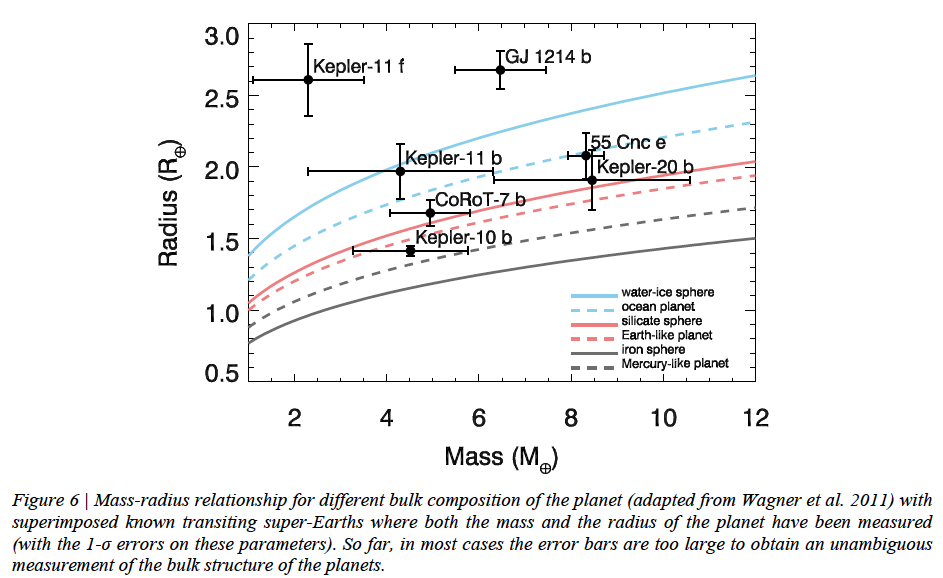
Figure 6 taken from
the CHEOPS Red Book
CHEOPS has a pretty simple design -- for a space telescope. The telescope is a 33-cm on-axis Ritchey-Chretien.
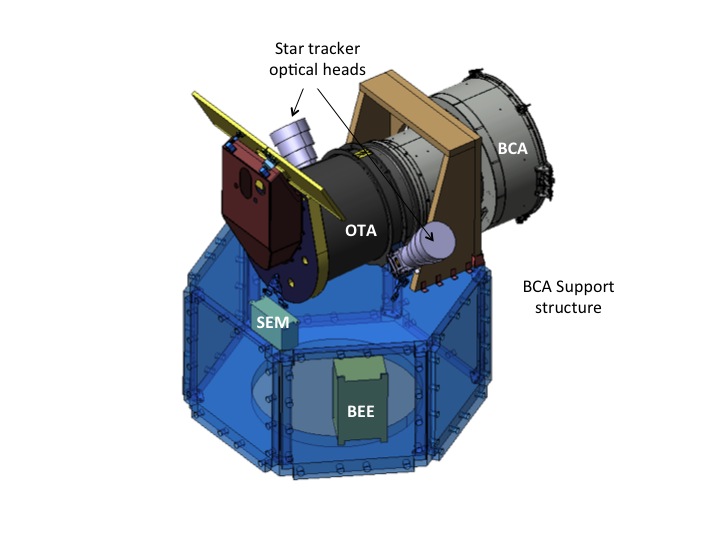
Figure courtesy of
the ESA's CHEOPS mission pages
Click on the figure below to zoom in.
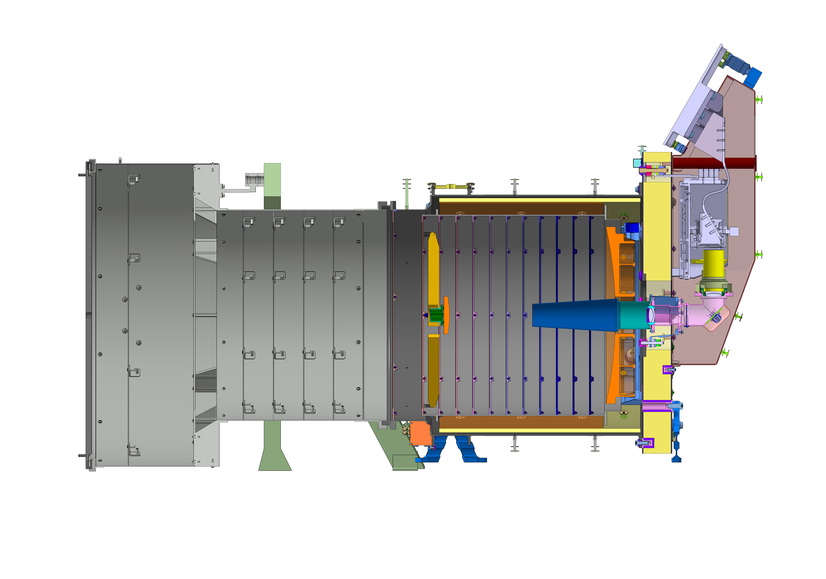
Figure courtesy of
the ESA's CHEOPS mission pages
The single CCD has a field of view of only 19 x 19 arcminutes with pixels roughly one arcsecond on a side. That may not sound like much, but it will provide at least a few comparison stars as well as the target. In order to increase the number of photons it can collect, the camera will be de-focused to yield a big, spread-out PSF about 30 arcseconds in diameter. Following in the footsteps of ESA's Hipparcos and Gaia missions, CHEOPS is likely to produce very few pretty pictures.
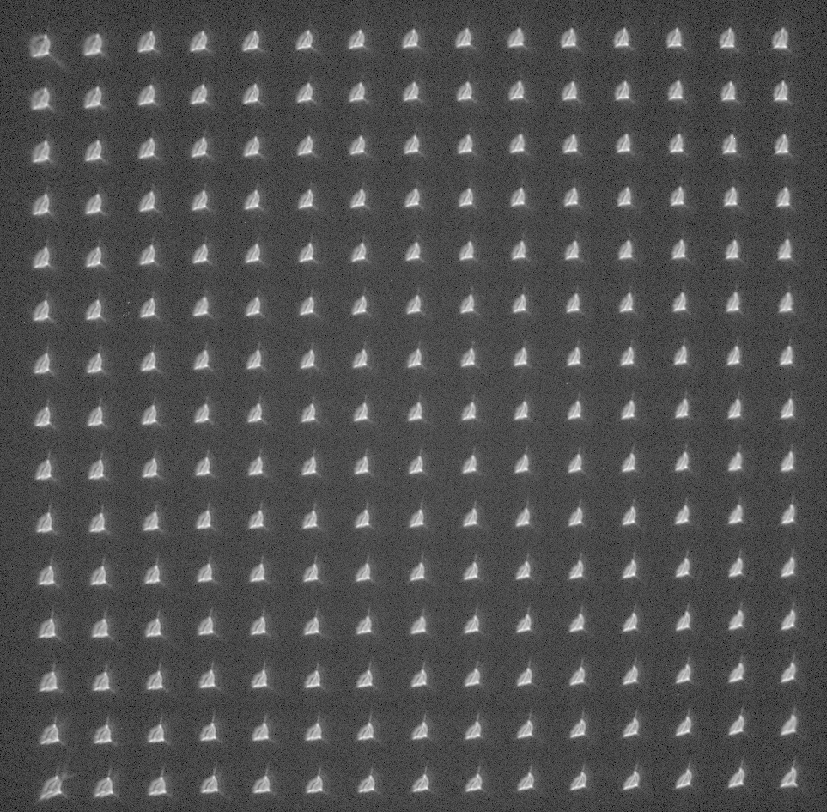
Figure taken from
CHEOPS picture of the week for Feb 27, 2018.
The goal of the project is to measure the intensity of bright stars with a precision of 20 parts-per-million (ppm) = 0.02 millimag. Below is a simulation of the individual measurements of a transit by an Earth-sized planet around a Sun-like star (cyan points), the measurements binned for one hour (black symbols), and a best-fit model to the transit.
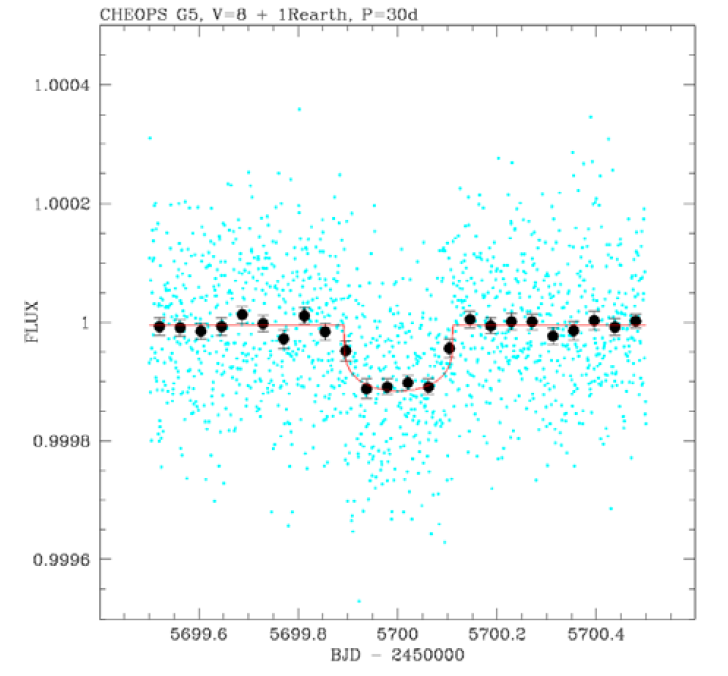
Figure 8 taken from
the CHEOPS Red Book
If we get lucky, CHEOPS may even be able to detect an exo-moon circling the exo-planet!
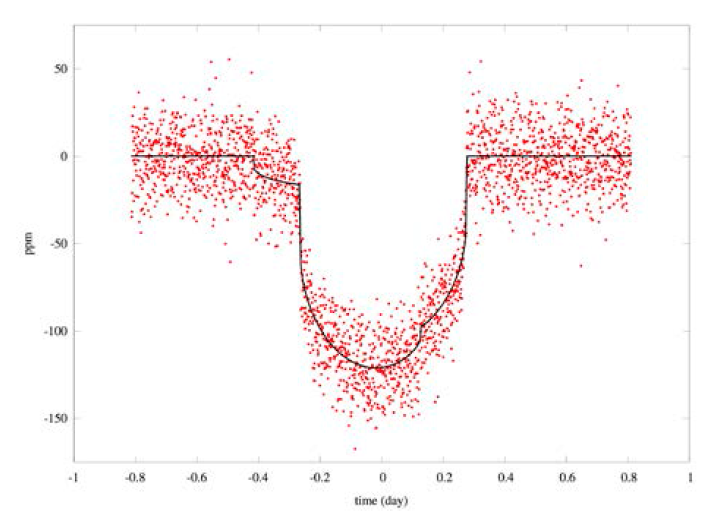
From Figure 15 taken from
the CHEOPS Red Book,
a simulation of an Earth-size planet's transit with
a 0.4-times-Earth-sized moon alongside.
CHEOPS will only be able to look at a relatively small number of systems over its planned 3.5-year lifetime. One preliminary target list would yield a set of targets like so:
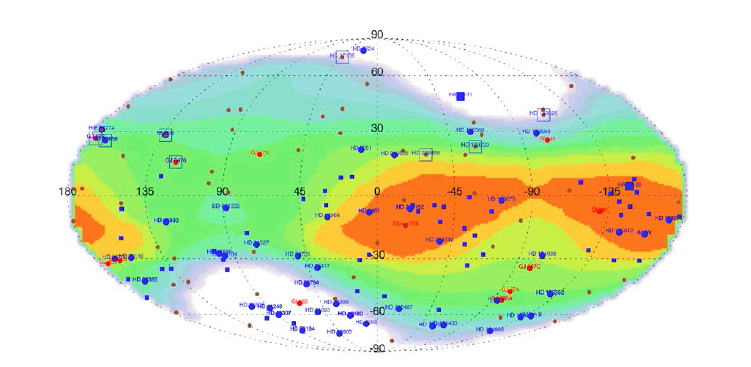
Figure 16 taken from
the CHEOPS Red Book.
CHEOPS is currently scheduled to launch in late 2018 or early 2019.
 Copyright © Michael Richmond.
This work is licensed under a Creative Commons License.
Copyright © Michael Richmond.
This work is licensed under a Creative Commons License.